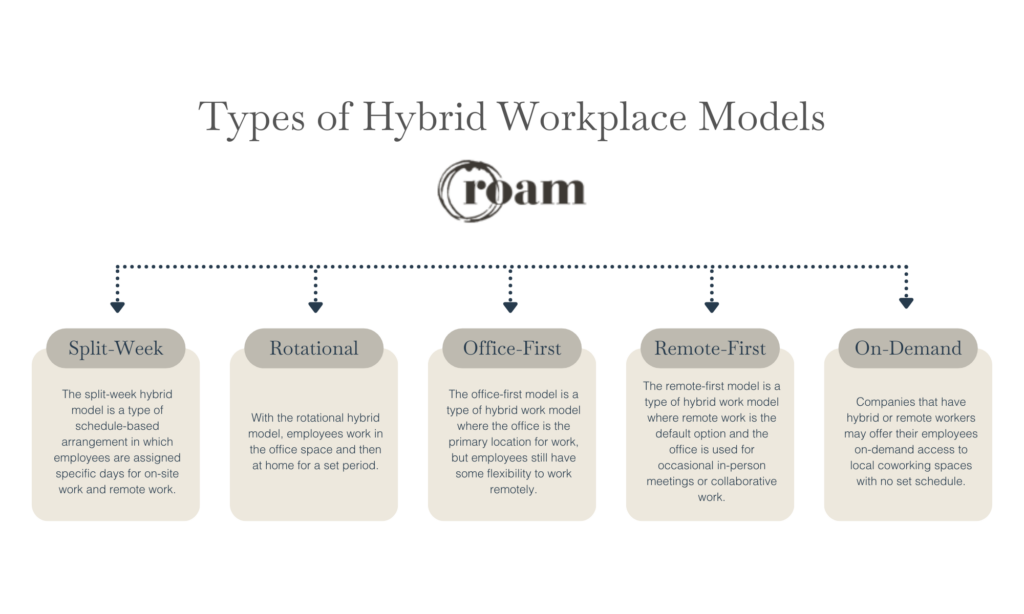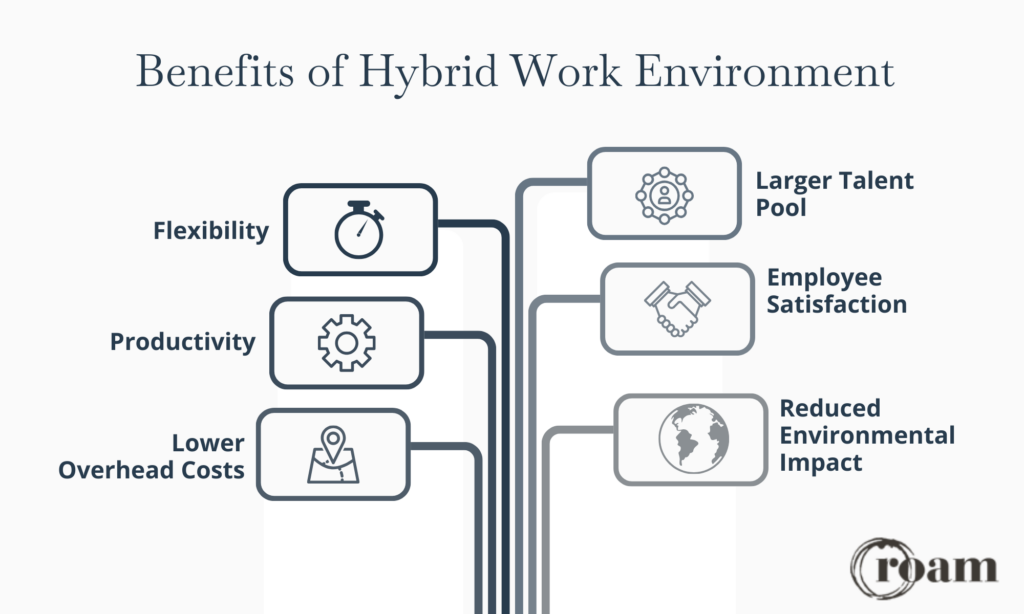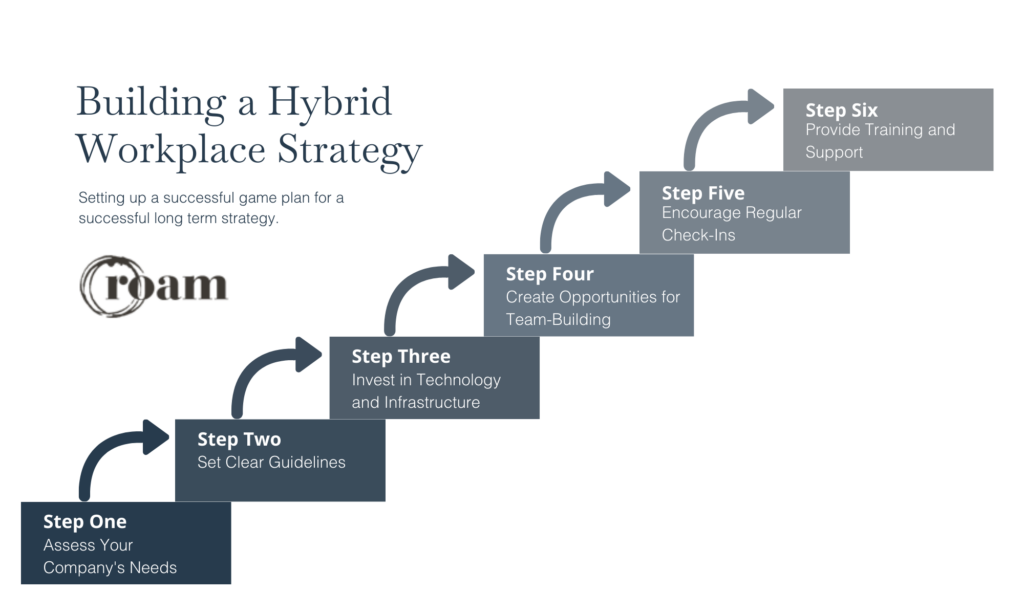How to Build a Hybrid Workplace Strategy

The working world is going through constant change, particularly with the popularity of hybrid work skyrocketing in recent years. Hybrid work was born out of a global pandemic and is now a commonly adopted model.
Let’s break down the types of hybrid work and strategies to deploy hybrid work seamlessly in your organizational needs.
What Is Hybrid Work?
Hybrid work combines in-office and remote work to provide employees with greater support and flexibility. With the hybrid model, employees have more control over how and where they work, giving them the freedom to design a work week that aligns with their own priorities and company policies. Organizations that allow a hybrid work schedule often find hybrid employees are more engaged and productive at work.
Types of Hybrid Workplace Models

1. Split-Week Model
The split-week hybrid model is a type of schedule-based arrangement in which employees are assigned specific days for on-site work and remote work. For example, a department may require one team to physically report to the office the first half of the week, and another team to work in-office the second half of the week.
2. Rotational Model
With the rotational hybrid model, employees work in the office space and then at home for a set period. The cycle of working in-office and then at home is repeated on a routine basis and can be customized to meet the unique needs and schedules of workers to improve the employee experience.
3. Office-First Model
The office-first model is a type of hybrid work model where the office is the primary location for work, but employees still have some flexibility to work remotely. This model is often used by companies that value face-to-face collaboration and interaction among employees, while still providing some flexibility to adapt to changing work environments.
4. Remote-First Model
The remote-first model is a type of hybrid work model where remote work is the default option and the office is used for occasional in-person meetings or collaborative work. It provides increased flexibility and reduced overhead costs and allows companies to attract top talent from around the world.
5. On-Demand Model
Companies that have hybrid or remote workers may offer their employees on-demand access to local coworking spaces with no set schedule. Instead of working in a home office that may not have the right technology or amenities, a remote employee can access a convenient workspace equipped with business-class Wi-Fi, meeting rooms, dedicated desks, and more.
Benefits of Hybrid Work Environment

- Flexibility – Traditional work models require employees to be physically in the office from nine to five. With the hybrid model, workers are granted more freedom and flexibility to work both in and out of the office.
- Productivity – A hybrid work model can empower employees to use their strengths, which in turn can boost productivity. It also allows employees who thrive in an office setting or remote location to work where they are most productive.
- Lower Overhead Costs – Hybrid workplace solutions can help reduce overhead and operating costs for businesses. With more remote participants, a business may require less physical space in the office, saving on real estate costs. Businesses can also save money on maintenance services and food expenses.
- Larger Talent Pool – Hybrid work can attract a larger talent pool by providing flexibility and accommodating diverse work styles. This allows companies to tap into candidates who may not be able or willing to work in a traditional office setting, such as those with family responsibilities or living in different locations.
- Employee Satisfaction – By providing a hybrid workforce with full autonomy regarding where, how, and when they work, you can increase employee job satisfaction.
- Reduced Environmental Impact – The hybrid work model greatly reduces the amount of commuting, as workers no longer need to travel as often to a physical location for work. In addition, the need for physical office space is reduced, which can lower a company’s real estate footprint.
Build a Hybrid Workplace Strategy

Hybrid work looks unique within every organization. Consider the specific needs of the organization, such as how many employees are needed for in-person work each day. In addition, look at which positions can be performed effectively at home, and which require in-office work. For example, many administrative duties can be performed remotely but direct customer service requires an employee to be in the physical office.
2. Set Clear Guidelines
Regardless of the hybrid work strategy chosen for an organization, having a physical office where employees can communicate, collaborate, and socialize is critical. Set clear guidelines on how the office should be used and make coming into the office a seamless employee experience. Consider setting up a collaboration platform that has a variety of collaboration tools that teams can use to schedule who will be in the office and at what date and time.
3. Invest in Technology and Infrastructure
Having access to the right technology can go a long way toward making a hybrid environment more effective for employees. Security remains a top priority for many organizations and remote working poses certain security concerns. Many businesses have had to alter their IT strategies to accommodate remote workers.
Collaboration tools are also a necessity for businesses that rely on a hybrid workspace. To maintain business continuity in and out of the office, businesses need the ability to track progress on common projects, efficiently share files, and communicate in groups through video calls or messaging systems. Having access to new tools can help increase productivity and morale.
4. Create Opportunities for Team-Building and Socializing
Hybrid work models often make it difficult for employees to build connections. Therefore, businesses must proactively create interactions that will help foster strong connections between coworkers. Team building and socializing activities can help employees get to know one another better.
Schedule team-building activities regularly and encourage every team member to participate. A team-building activity can be performed in the office, such as a trivia night or scavenger hunt. It can also be done outside the office, such as at a local escape room.
5. Encourage Regular Check-Ins
While many businesses find value in remote work, working away from the office can lead to isolation and communication problems. It is important to encourage employees to check in regularly to ensure that everyone is on the same page. Routine one-on-one check-ins between employees and managers can help bring any issues to light and avoid misunderstandings.
There may be instances when employees cannot make it into the office to check in physically, but that doesn’t mean that check-ins can’t happen. During these occasions, request that employees check in via video conference. Having face-to-face communication is key for employee engagement and can help make all employees feel equally supported by the hybrid workplace.
6. Provide Training and Support
Having a hybrid workforce can be tough as not all employees are in the office at the same time. Additional training and support are often needed to help bridge communication gaps and maintain a smooth workflow. Hosting regular in-office training sessions or live online training can help distributed teams interact and get caught up with new changes within the company.
It can also be useful to have training available on demand to allow employees to undergo training when and where it makes the most sense for them. When employees are permitted to train independently, they are more likely to devote their time and concentration to the information being delivered.
How to Overcome Challenges of Managing Hybrid Teams
- Miscommunication – Miscommunication is common in hybrid work environments as messages sent via email or other channels may not always be clear or written in the right tone. Hybrid employees require one-on-one communication at least once a week to build connections and avoid conflict.
- Collaboration & Employee Productivity – Collaboration can be challenging when not all team members are in the same room at the same time. Shifting from synchronous collaboration (working collectively in real-time) to asynchronous collaboration (individual work contributions) can help minimize disruptions and ensure projects are done on time.
- Team Building & Company Culture – It can be difficult for employees who work remotely to build relationships with other workers. Hosting virtual events or other team-building activities allows for more effective communication and collaboration.
- Better Work-life Balance – Many employees find it difficult to maintain a healthy work-life balance, especially when working from home. It is important for businesses that allow remote or hybrid work to provide employees with support and wellness benefits to prevent burnout.
- Technical Issues – Companies that offer hybrid work opportunities often run into more technical issues than businesses that have a traditional work model. Businesses must implement updated technologies and policies to ensure that employees have access to the technology they need and that all sensitive information is kept secure.
- Trust and Accountability – Hybrid workers may have difficulty balancing flexibility and accountability. Businesses need to define clear expectations and outcomes for each project and team member.
A hybrid work environment can be a valuable workplace strategy, allowing employees to maintain greater flexibility and productivity, while enabling employers to achieve lower overhead costs, access to a larger talent pool, and reduced environmental impact. Roam has helped countless businesses achieve a successful hybrid workplace strategy by delivering flexible and fully customizable workspaces, essential amenities, and multiple membership options. Contact Roam today to schedule a tour or book a room.
